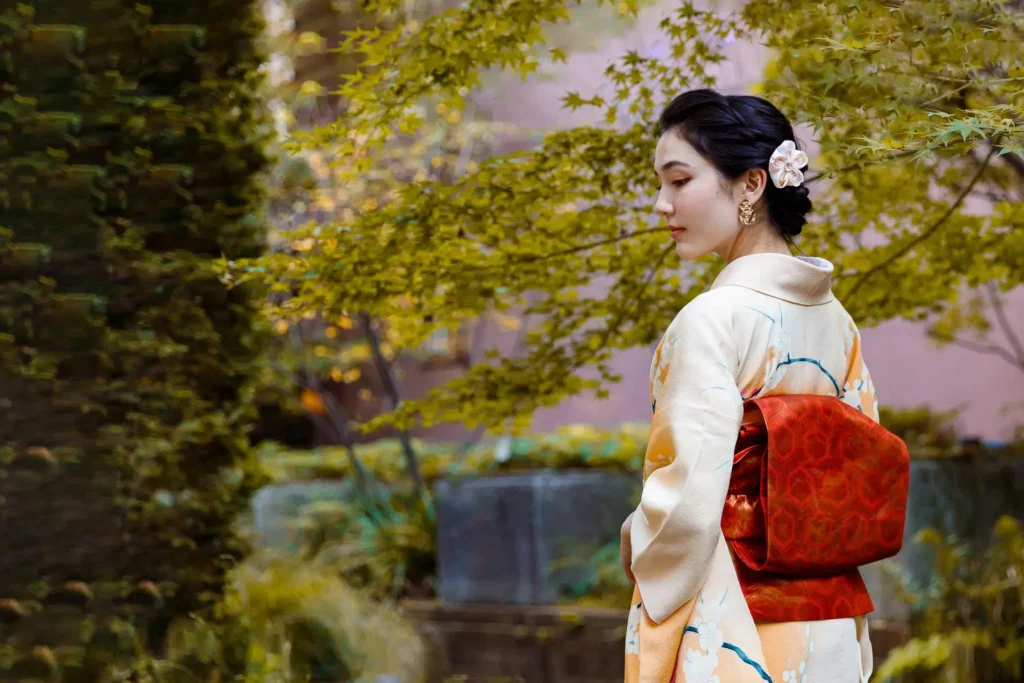1. Kimono
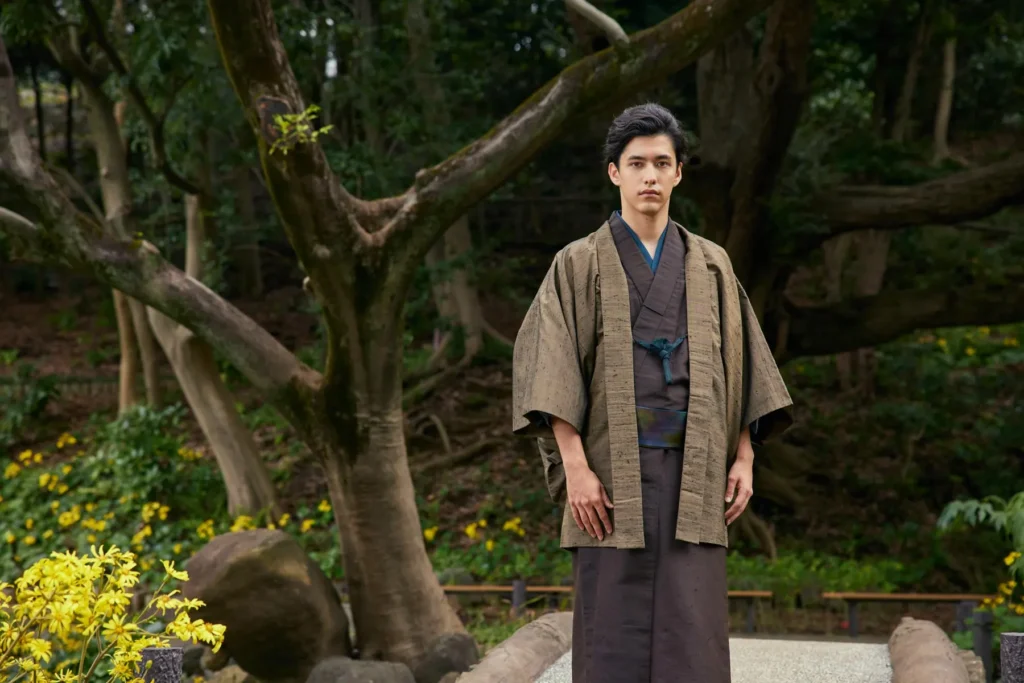
The kimono (靀物), the most recognisable and iconic of all traditional Japanese clothing, is becoming more and more popular outside of Japan while remaining a wardrobe need for many Japanese people. Originally worn with a hakama, a long skirt-like garment with a divider along the middle, the kimono was modelled after ancient Chinese apparel. But as time went on, fashion altered, and wearing the kimono without the skirt and instead pulling it together with an obi sash became much more common. The kimono has withstood the test of time. Usually worn for formal occasions, both traditional and modern, its body-hugging silhouette and flattering fit are a timeless symbol of Japan’s profound admiration for thoughtful beauty.
2. Yukata

The yukata (恅衣) is the summertime equivalent of the kimono, to put it simply. The garment was originally designed as bathing cloth, hence its name, and it is made of soft, light fabric like cotton. The yukata is an easy-to-wear garment that can be worn by both men and women. It is secured with an obi. During the hot summer months, this fashionable and airy robe is also the unofficial attire for colourful summer matsuri gatherings. It is most commonly worn while onsen bathing.
3. Hanten

During the Edo period, common people wore hantens (半溏), which are winter coats. Even though the jacket has a long history, its straightforward, simplistic style makes it an extremely adaptable item of apparel that fits right into any modern wardrobe. The coat-jacket has a throw-over shape and is fitted and padded for a comfortable yet attractive fit. This is a great place to start if you want to add some Japanese Clothing flair to your outfit, and even better, we’ve already written a whole tutorial on it.
4. Haori
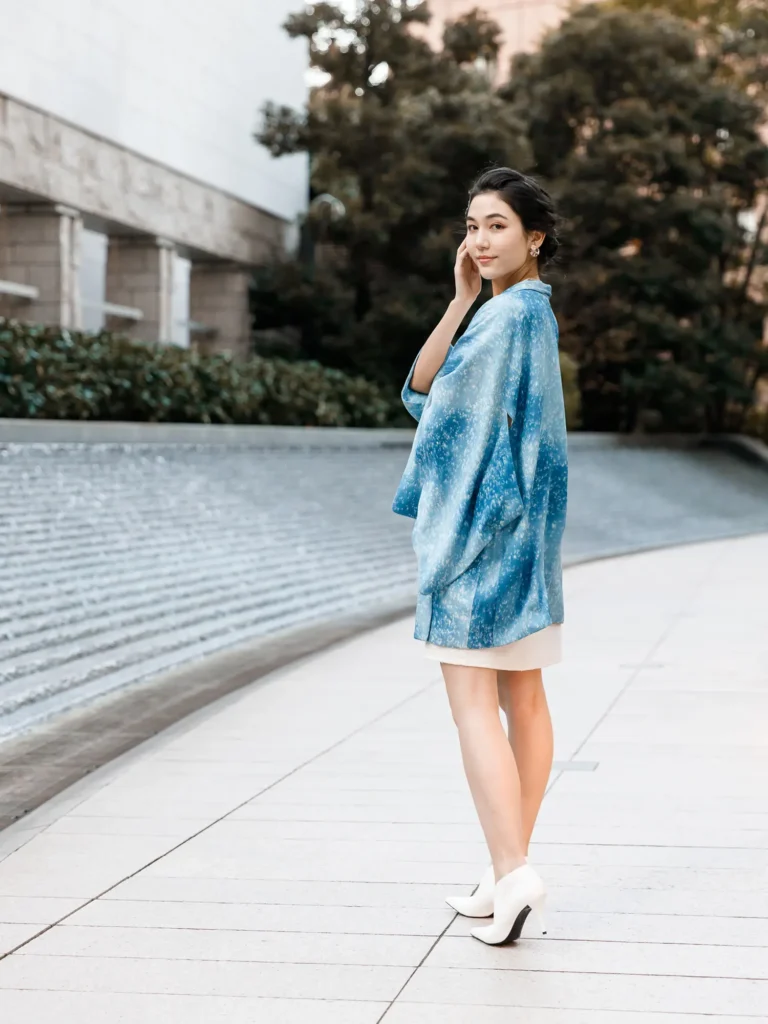
A haori (捽湔), a medium-length jacket worn over a kimono, is a more formal version of the hanten. was only available to people of a higher social class in the past, but during the Sengoku period, men would cover their armour with sleeveless haori, much like Europeans did with tabards. In the 1800s, women dabbled in donning the haori as a bold fashion accessory, a trend started by geisha.
The laborious shibori method is used to hand-dye this haori kimono jacket. To produce complex patterns between the dyed areas and raw cloth, portions of the fabric are tied together before being submerged. This has been made by hand-tying each of the hundreds of tiny dots that you see.
5. Samue

When engaging in the physically demanding, attentive task known as samu, Japanese Clothing Zen Buddhist clergy used to wear the remarkably simple samue (潜務衣) garment. Cooking, cleaning, and outdoor work are all included in the samu category of activities, and they’re all considered to be great approaches to practise mindfulness. They’re usually made of linen or cotton and stained indigo blue or brown, and they consist of a basic shirt and trousers. Its deliberate design and subtle simplicity make it a superb illustration of Zen Buddhism in action. Check out these Ten Things to Know about Samue to learn more about him!
6. Kimono Robes
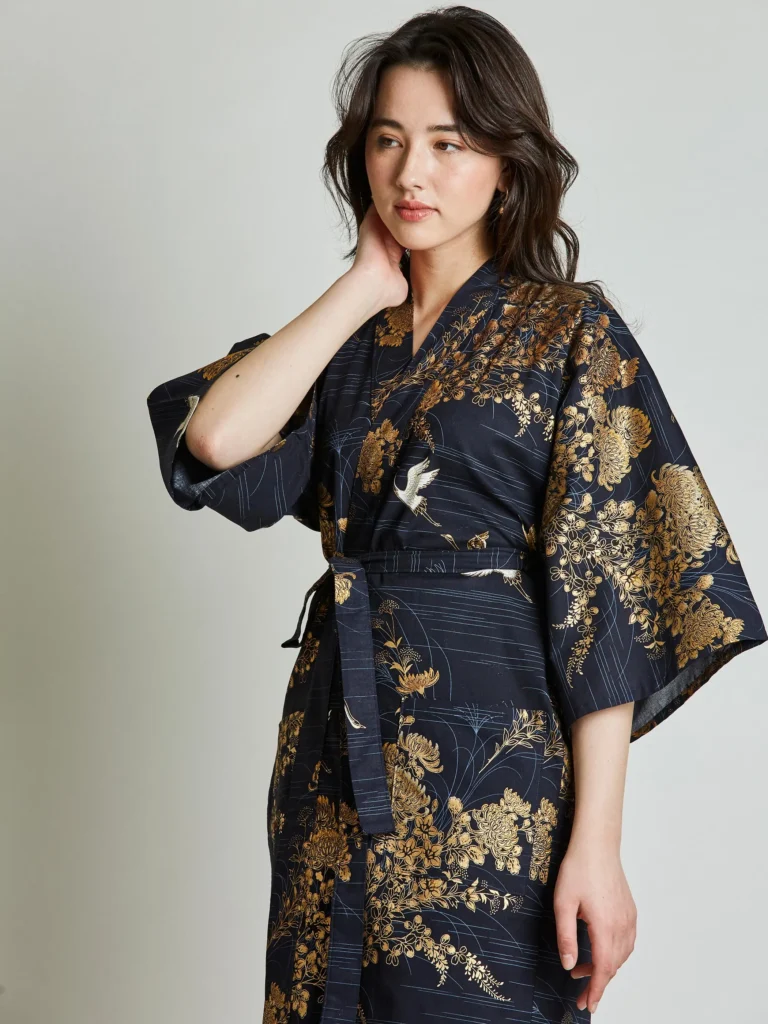
Actually, a yukata—the more casual and laid-back equivalent of a kimono—is more like to a kimono robe. The history of ryokans, or Japanese Clothing-style inns with onsen hot springs, is entwined with the culture of bathing. Japan’s bathing culture stretches back to the Kamakura era, which began in the 12th century.
These days, yukata in a ryokan are more simply worn than ever before thanks to a straightforward waist tie that resembles a bathrobe. They don’t need intricate folds, additional knots or special pants.
A kimono robe is precisely this—a basic yukata that is typically worn at home rather than at a ryokan. 23 Things You Should Know About Japanese Clothing Kimono Robes has further information!
7. Men’s Nagajuban Robes

Under a kimono, men’s nagajuban are worn to keep it dry and clean. These kimono undergarments are often made of silk or white cotton, but you may also find vintage nagajuban with intricate hand-painted artwork that would be perfect as loungewear robes! View the assortment by clicking this link.
8. Obi
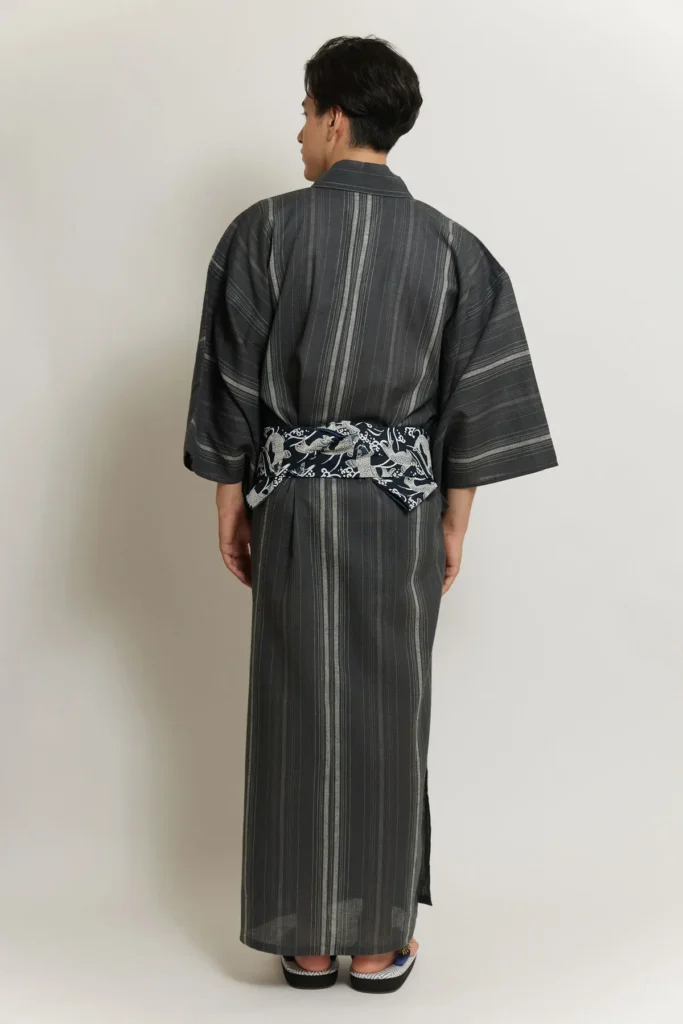
The obi (踯), the sash that holds the kimono together, is sometimes disregarded, yet when worn correctly, it’s a distinctive element of traditional Japanese clothing. Every occasion and style can be accommodated with a different sort of obi, no matter how basic or elaborate you choose. The designs can be selected to create a striking contrast or to complement the kimono’s material. In certain ensembles, the kimono turns into a blank canvas where the obi’s craftsmanship is showcased. For ladies, the obi serves mostly as a decorative accent; underneath is the real piece of fabric that holds the garment together.
Because men’s obis are narrower than women’s, they are more useful in keeping the kimono taut. However, as men’s kimonos and yukata frequently include muted hues like grey and blue, accessorising with a patterned or coloured obi is a wonderful way to show off one’s individuality and sense of style.
9. Obijime
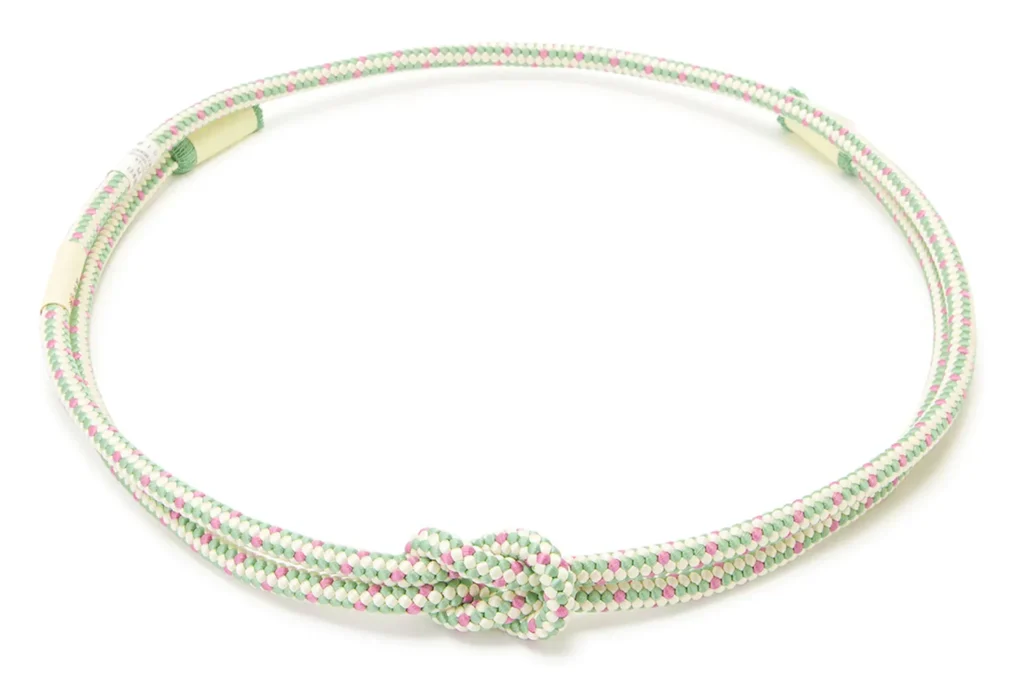
The front of the kimono is knotted with an obijime (帯締), a decorative braided cord that is tied around the obi. They were believed to have been gifts from a patron or lover at first, but now you can get your own! Obijime comes in a wide range of patterns, hues, forms, and textiles, and is a staple of most contemporary kimono combinations. But the most well-liked obijime are typically made of silk.
10. Obidome

An obidome (帯留) is a little item that is threaded through an obijime, akin to a necklace pendant or bead. It is frequently found combined with obijime. Obidome can be nearly anything, ranging from inexpensive ornate brooches made of ivory, pearl, and diamonds to basic wooden and clay beads. Some of the earliest known obidome were recreated from ornate metal components that were formerly used in Japanese Clothing swords. Although obidome were once a rather informal embellishment to kimonos, they are now often utilised in formal kimonos.
11. Obiage

The obiage (帯揚) is the last piece in the obi-trio. The obiage, which has a shape akin to a silk scarf, is rolled and placed between the kimono and obi belt to add a tiny splash of colour. Its purpose is to conceal the strings of the obimakura, or obi cushion, making the kimono appear more elegant and well-groomed. Obiage is often composed of cotton, polyester, or silk and is available in an almost infinite variety of colours that are selected to go well with the kimono’s other colours.
12. Nagajuban
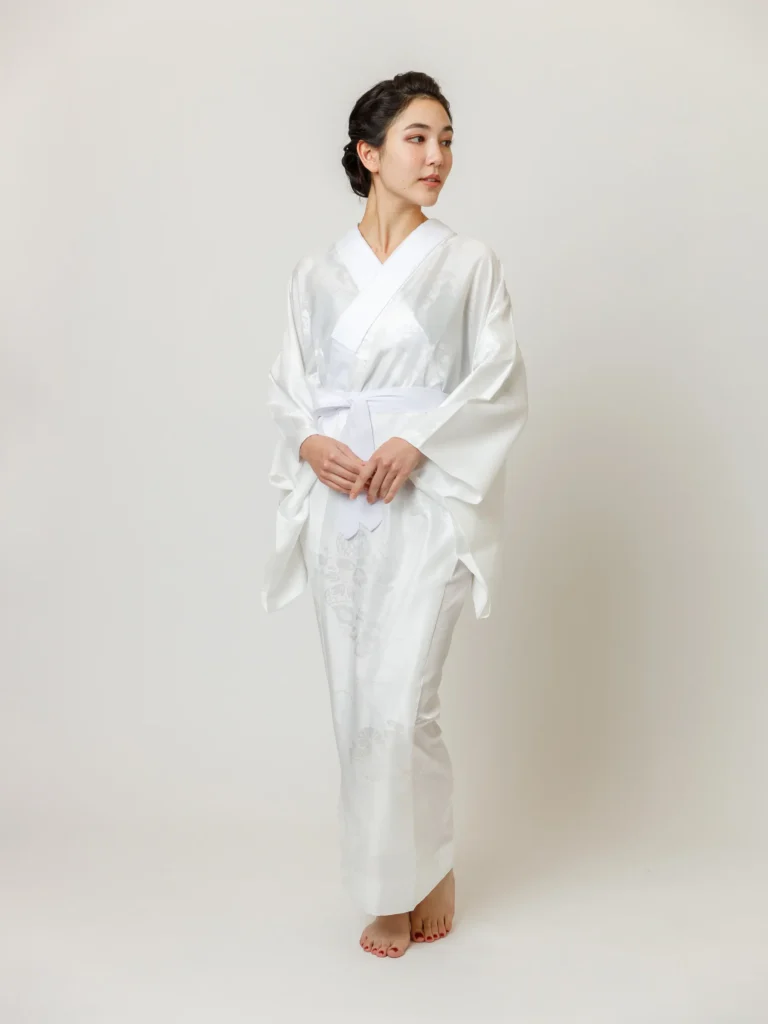
A nagajuban () is a thin robe used underneath a kimono to keep the remainder of the garment clean. The garment, which is usually made of silk or cotton, keeps the kimono’s layers apart from the wearer’s body. The nagajuban is essential to keep perspiration away from the outer material of kimonos, which can be quite difficult to clean, especially if they are made of silk. Usually, the nagajuban is only noticeable as a thin white stripe at the collar.
13. Tabi
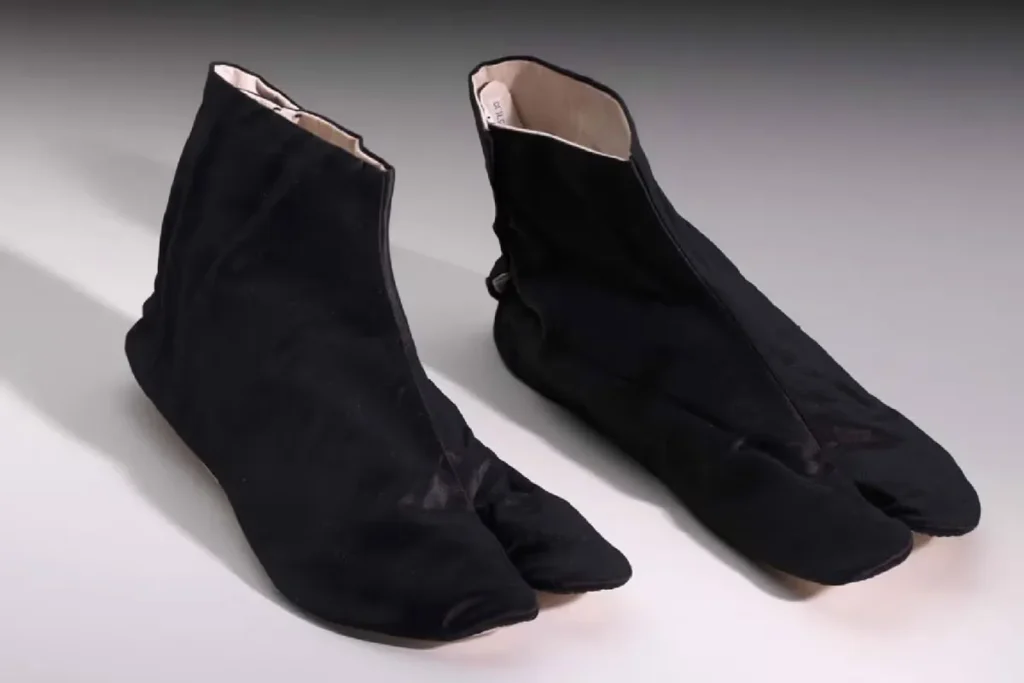
The tabi (鶳颋), a traditional piece of footwear worn for many purposes by both men and women, is a combination of a shoe and a sock. Similar to a mitten for the foot, the tabi style divides the big toe from the others! The most typical way to wear tabi is as socks under a kimono. The sock split makes it simple to pair the item with traditional footwear, such as geta and zori. Although tabi was traditionally white, it is now available in a wide variety of colours and patterns. View our assortment by clicking this link!
14. Geta
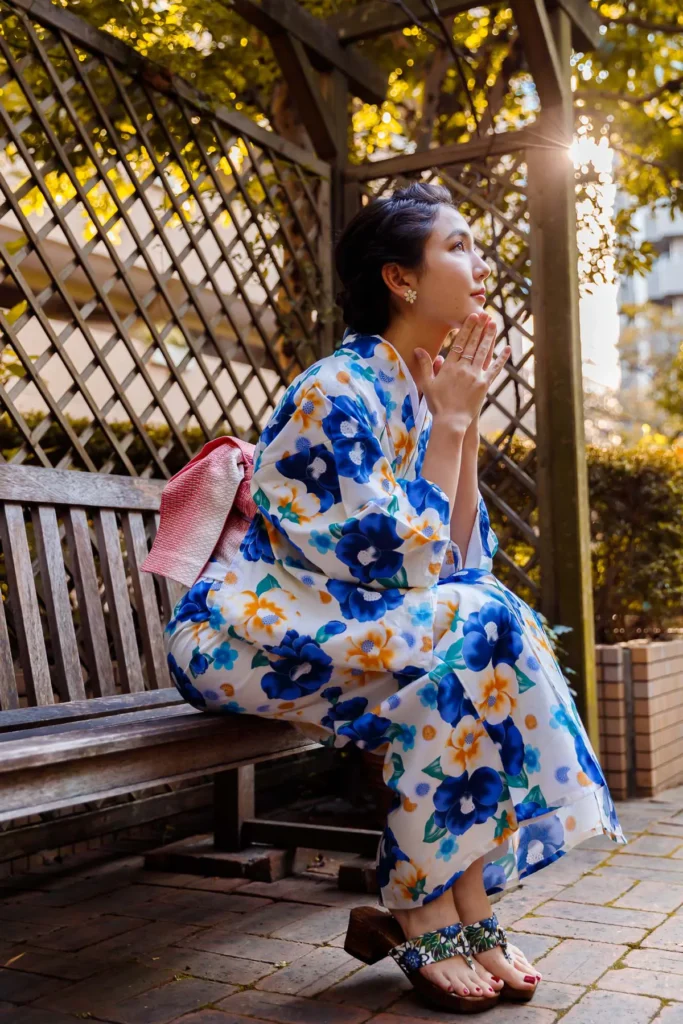
Geta (下駄) are wooden shoes that resemble clogs and are raised off the ground by wooden teeth. They are surely familiar to you from any woodblock print, as they were once frequently worn as formal attire. Nowadays, though, individuals are more likely to see a version that is much lower to the ground because they are not as accustomed to stepping on these high-rise shoes. They are typically worn with yukata and other summertime attire, and they have a slightly more informal vibe than zori. Visit our article on Japanese Clothing Geta to learn more about the shoe, its history, how to use it in a modern setting, and other related details.
15. Setta

It may surprise you to learn that while all zori are not setta, all setta are a type of zori. Because they are lighter, softer, and have a flat heel, setta (雩駄) are easier to wear than other traditional footwear. Setta sandals have an extra leather sole that adds toughness and water resistance, unlike zori’s straw or wooden sole. Because of this, it is more resilient to the humidity of Japanese summers and suitable for the rainy season. Often, the heel setta has a metal clasp that produces a unique sound while you walk. Look through our selection if you’d want to give setta a try!
16. Zori
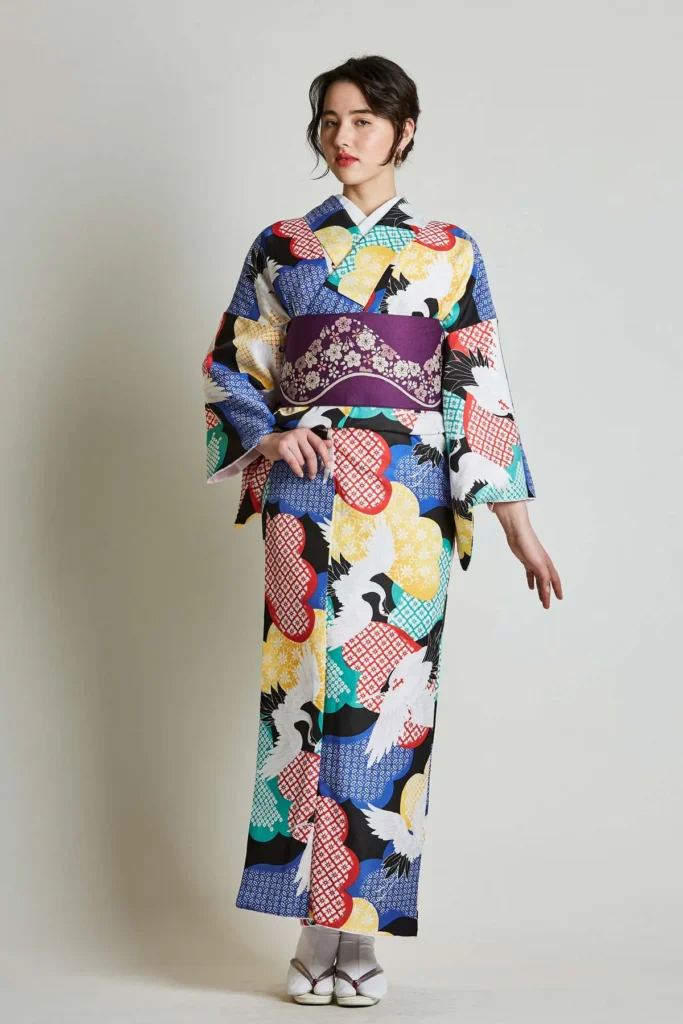
For both men and women, zori (鍉履) are the preferred footwear for formal Japanese attire! Over time, they have been constructed from a wide range of materials. Although the letters directly translate to “straw,” they are now frequently fashioned of synthetic materials. Their straightforward flip-flop form makes them a simple addition to any wardrobe. Zori are typically worn with tabi socks and can be dressed up or down depending on the colour of the toe strap, or hanao. Men’s zori have a flat profile, while women’s zori have a wedge-like form. Visit our article on Japanese sandals to learn more about the variations in traditional Japanese footwear.
17. Maekake
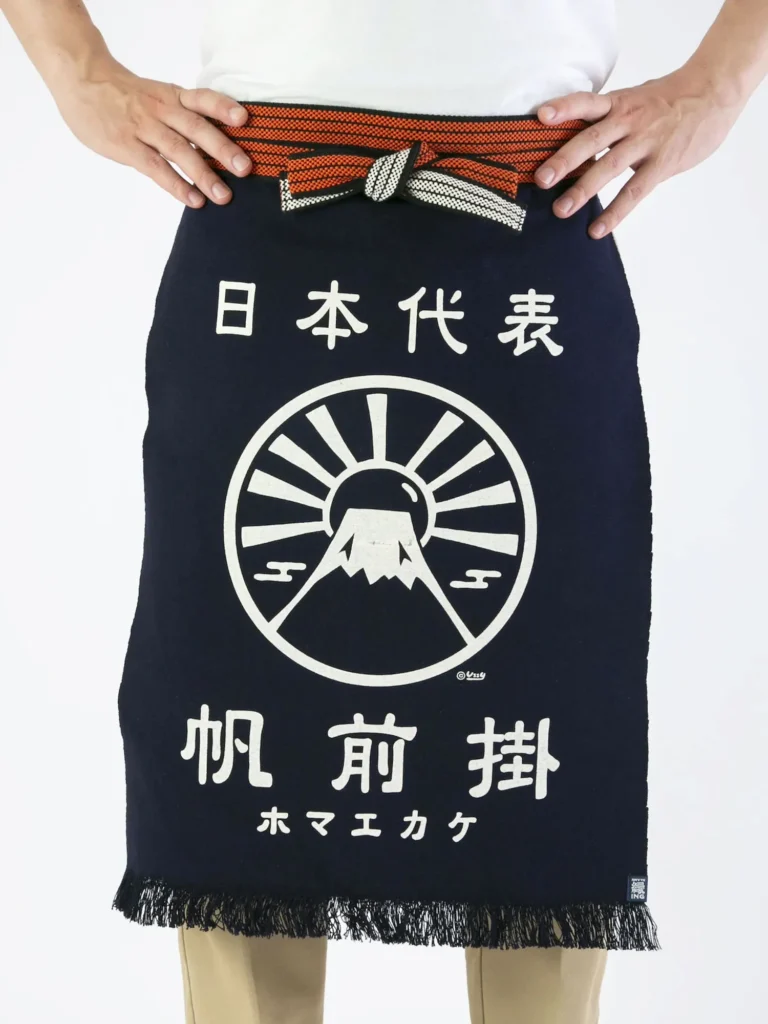
Maekake (前掛) is a traditional form of Japanese apron that is tied at the front and worn on the hips. The name literally translates to “front-worn” or “front-hang.” Maekake were formerly worn by artisans and employees of a range of establishments, including as sake, rice, and miso shops. Many people utilised the thick cotton canvas, coloured in indigo, as shoulder padding when lifting big weights since it is durable. These days, many vegetable and rice merchants still use maekake, and employees at Japanese Clothing pubs, or izakayas, wear them as well.
18. Jinbei
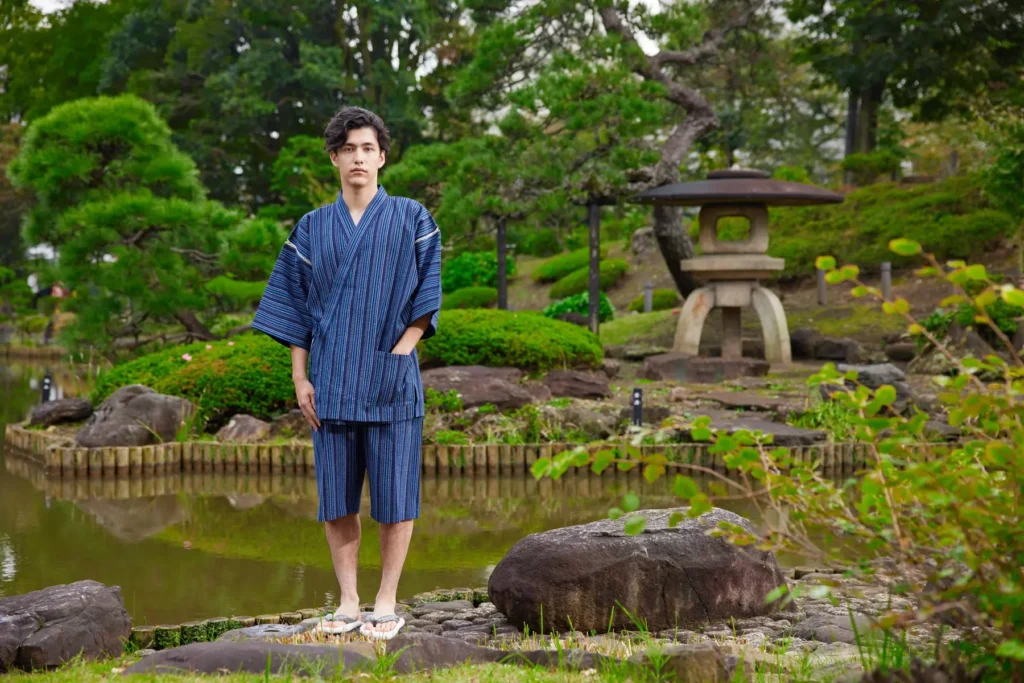
Jinbei (甚平), which resemble samue in appearance, are typically worn by common people and hence have more decorative flourishes than their Zen Buddhist cousin. The matching shirt and trousers combination, made of sturdy yet natural materials like hemp and cotton, is a summertime house uniform that can be worn by both men and women as well as kids. Boys are the ones that wear them the most; they may wear jinbei to the same occasion where girls wear yukata. Jinbei are typically worn at home, although they’re also appropriate for going on errands, attending matsuri celebrations, and unwinding at an onsen resort.
19. Tenugui
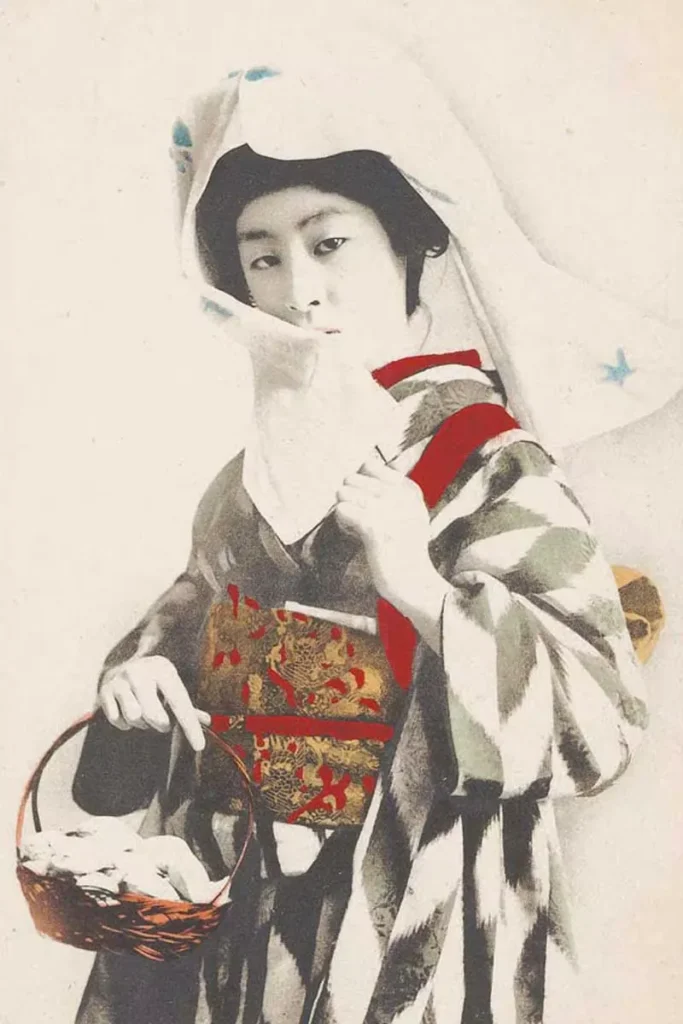
Though modest in appearance, Tenugui (手拭い) is undoubtedly not in use or significance. It is a useful piece of fabric with an almost limitless range of applications, as we have discussed in Japan Objects magazine. It is consistently patterned in exquisite Japanese styles. In addition to being used for gift-wrapping and household purposes, kendo fighters adore using it as a kind of headscarf since it provides a convenient means of keeping their hair out of their faces. Get your own tenugui by looking through our inventory!
20. Hakama
In some aspects, the hakama () served as a forerunner to the modern kimono, drawing inspiration from the trousers used in the Chinese imperial court during the Sui and Tang dynasties. There are two types of hakama: the divided umanori, or horse-riding hakama, which resembles loose-fitting trousers, and the undivided andon bakama, which resembles a long pleated skirt. The hakama’s status in Japanese society changed over time. Nowadays, women usually reserve the use of hakama for graduation ceremonies and traditional Japanese sports like kendo and aikido, while men are more likely to wear it underneath their kimono for both formal and informal events.
21. Happi
If you see someone wearing a charmingly named happi (法被), which is most commonly seen in deep blue indigo or brown, it usually signifies they are heading to a festival. The back of the happi is typically ornamented with a crest. It’s a light, comfy jacket with sleeves that are somewhat shorter than full length. Originally, these crests belonged to families, since Japanese housekeepers wore happi. Currently, though, they are mostly used to identify teammates at a matsuri (Japanese festival), such as a team member who carries a mikoshi.
22. Tanzen

Another type of kimono that is typically worn by males in the chilly winter is the tanzen (渹前). It keeps the fundamental shape of a kimono, but is heavily padded to keep out the cold rather than having the plain lining of the typical garment. It is typically constructed of thicker cotton, rather than the more ornate silk, and is coloured and patterned in a way that appeals to men’s fashion tastes, befitting its winter practicality. most frequently observed in Tohoku and Hokkaido, two of Japan’s more northern regions.
23. Michiyuki
Michiyuki (), which means “travelling” in Japanese, is a traditional coat that is worn over a kimono to provide warmth and protection, akin to a windcheater in the West. Though they are worn over the kimono, michiyuki have a more utilitarian and defensive purpose than haori. Michiyuki frequently have very little or no patterning and have rather straightforward designs. A distinguishing feature of a michiyuki is its square-shaped neckline, which is buttoned up front. The term “michiyuki” actually refers to the design of the coat’s collar, which is thought to have originated from the travelling kimono, or michiyuki kimono, that men used to wear on their trips a few centuries ago. Unlike Haori, the Mikiyuki
24. Tonbi Coat
Tonbi coats (鳶) are overcoats with short connected capes worn over the top of kimonos, inspired by the Victorian-era inverness capes used by celebrities such as Sherlock Holmes. Wearable by males, the tonbi, which is typically made of wool or cashmere cloth, is sleeveless to accommodate kimono outfits while maintaining a slightly Western vibe. The late 19th and early 20th centuries saw a boom in the popularity of tonbi jackets. Tonbi are the ideal outerwear for a stroll in the park during the cooler months, despite becoming somewhat difficult to find in recent years.
25. Gakuran
The stylish, classic boy’s high school uniform known as the gakuran (学ラン) is probably something you have seen in many manga and anime series if you are not from Japan. It consists of a long, buttoned coat with an upright collar, full-length pants, and usually black dress shoes. The clothing worn by European navy personnel served as the model for this uniform, even if we no longer see it as a staple of Japanese fashion. It’s important to note that there is a female version of the uniform that is based on a similar design. It’s called the sailor fuku, and it consists of a white blouse, a coloured neckerchief, and a navy blue skirt.
26. Fundoshi
Among the most iconic items of traditional Japanese clothing are the men’s undergarments known as fundoshi (餌). After World War II, Japanese people began wearing cotton briefs instead of the more common western-style underpants. Although there are several variations of the fundoshi, the one that is most well-known these days is the one with the loose apron-like front, which is frequently seen at Hadaka Matsuri, the nation’s iconic naked festival held in Okayama in February.
27. Tobi Pants
Tobi () are extremely baggy trousers that are most frequently seen on Japanese workers. At first impression, they resemble a throwback to rave fashion from the 1990s rather than practical, hard-working attire! The moniker, which derives from the colloquial terminology for the high-rise construction workers who don them, implies “kite,” as in the bird of prey. It is stated that by being so loose, they serve as an early warning system by lowering things before they have a chance to reach a worker’s legs, in addition to providing comfort and flexibility. Wearers of Tobi can carry on with their task without looking down to see if there are any obstructions.
28. Hachimaki
A head wrap that resembles a bandana, the hachimaki (鉢巻) is a beloved accessory among sushi cooks nationwide. They come in helpful to stop perspiration from getting in your eyes on hot days. These days, they’re usually worn for fashion, especially at competitions and tournaments, when many are emblazoned with inspirational phrases. Though its exact origins are unknown, theories suggest that samurai originally used them to shield their foreheads from being cut by their helmets.
29. Judogi
Judogi () are the traditional clothes worn in Japanese martial arts practice and competition. They serve as the model for many other current outfits. Jigoro Kano created judogi at the beginning of the 20th century. It was inspired by the kimono and other traditional Japanese fireman outfits, such as the bulky hemp hanten. A judogi set consists of lighter canvas trousers (shitabaki or zubon), a cotton belt (obi), usually made of bleached white cotton and a fairly hefty jacket (uwagi). Despite a few changes throughout time, the uniform largely remains unchanged from what was worn a century ago.
30. Karategi
The karate outfit, known as kataegi (空手着), is derived from judogi. To maximise movement and speed, the karategi’s material—smooth cotton or canvas—and cut are often significantly lighter and looser fitting. Since judo does not entail wrestling, karate does not require the judogi’s incredibly tough and coarse fabric. Contemporary karategi are now available in a greater range of hues.
31. Jujutsugi
The training clothing for the Japanese martial art of jujutsu is called jujutsugi (柔術着). The thick, heavy cloth is the same as in judogi, but the sleeves fit closer and are thinner. It’s crucial in jujutsu to avoid getting grabbed by your opponent, therefore judogi’s looseness would be a disadvantage.
32. Aikidogi
The aikidogi (合気道着), the equipment used in aikido, was developed and given its current shape in the 1960s by a well-known Japanese company that had first focused on Judo gear. Aikidogi comes in two primary varieties: one that is nearly exactly like the original judogi, complete with jacket and trousers, and another that adds traditional hakama on top of the standard judogi. The jacket usually has longer body and shorter sleeves when worn with hakama, which makes it easier to tuck into hakama. There is also frequent usage of the lighter karategi jackets.
33. Kendogi
The clothing used in kendo, a modern Japanese martial art that incorporates both bamboo swords and protective armour, is called kendogi (剣道着). The outfit is inspired by samurai clothing, just like the sport, which is founded on ancient swordsmanship. The fundamental outfit comprises of a jacket and hakama, both of which are composed of strong cloth to absorb blows from opponents. With its fastening bands beneath the belly button and its trapezoid-shaped back piece—which is crucial in kendo—the hakama also promotes proper posture. Athletes in kendo wear armour, which is made up of several pieces to protect the head, shoulders, arms, throat, and body, much like in the Western sport of fencing.


